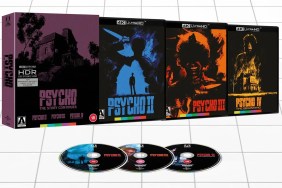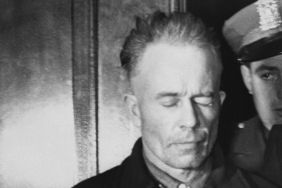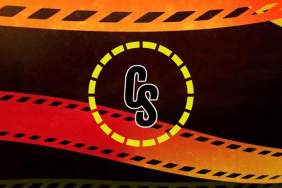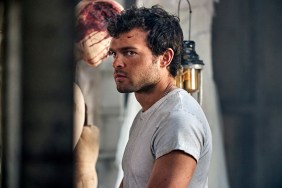Jeff gets cozy with Norman Bates again

No one trick or treats on the last day of school, no one carves jack o’ lanterns on July 4th, or goes on haunted hayrides in August.
When it comes to beloved macabre traditions, the fall is the season that gets all the attention. Thanks to the celebration of Halloween, the autumn months have always been indelibly associated with all things frightful. Summer, on the other hand, is ostensibly all that horror isn’t about â a golden time of warm weather, trips to the beach, fireworks, road trips and family picnics.
For those movie buffs that prefer the inside of their neighborhood cinemas (or, for some, the nighttime chill of drive-in theaters) to the blistering heat, however, the summer is the real witching season. Some believe that horror vacations in summer, waiting for fall to arrive, but box office history tells a different story.
Starting in 1975 when Jaws invented the modern blockbuster by teaching a generation to be afraid of the ocean, summer has been the best time of year to be scared. The fall can keep Halloween. It can keep the costumes, the candy, the Great Pumpkin, all of it â because summer has always had the better movies.

Sequels have always presented an arduous challenge for filmmakers. But to make a sequel to Alfred Hitchcock’s Psycho (1960), the shocker that single-handedly changed the course of modern cinema? That was more than just a challenge. That was the Mt. Everest of sequel projects. The idea of anyone attempting to make a Psycho II â over twenty years after the original, no less! â sounded like pure craziness. But then, we all go a little mad sometimes.
Inspired in part by his disdain for the slasher genre of the early ’80s, and prior to the development of the Psycho II film, Psycho novelist Robert Bloch had his own idea for a continuation of Norman Bates’ story. Bloch had the still-nuts Norman escape from an asylum (by murdering a nun and dressing in her habit) and subsequently treks to Hollywood to terrorize the makers of a movie based on his exploits (that it would’ve taken twenty some-odd years for Hollywood to make a movie out of Norman’s grisly deeds seems far-fetched to me, but whatever). Bloch’s Psycho II was published in 1982 but with its acerbic jabs at Hollywood and the way the storyline marginalized Norman, it didn’t make for a viable candidate for a movie adaptation.
Still, Universal recognized the strong public interest in the property and set about mounting their version of Psycho II. Screenwriter Tom Holland (The Beast Within) was enlisted to create a storyline from scratch and in the director’s seat was ardent Hitchcock disciple Richard Franklin, who had previously proved his aptitude for suspense with the acclaimed Australian thriller Road Games (1981). The importance of having the right writer and director aside, the success of any attempt at a Psycho sequel hinged on the participation of Anthony Perkins. The actor’s (at first reluctant) decision to return as Norman was the essential casting coup that made Psycho II into a credible project. In the summer of 1983, the Bates Motel would be back in business. Cue the slashing violins!

>As a fan of the original from having seen it on TV but too young to feel any film nerd outrage at such sacred cinematic ground being tread on, Psycho II was far and away my most anticipated movie of the summer of ’83. For the more skeptical, however, the film’s release in June of ’83 was an opportunity to discover that Psycho II was a top-shelf horror thriller â a worthy successor to the original.
From the instant a judge declares Norman fit to return to society, Lila Loomis (Vera Miles), formerly Lila Crane (and the sister of Norman’s most famous victim, Marion Crane) is in the courthouse calling bullshit and waving a petition to keep this murdering menace locked up for life. Even though she’s something of a high-strung, haranguing bitch (can you blame her?), Lila might be onto something as no sooner than Norman returns to the Victorian frame house he used to share with his mother’s corpse does he see someone in the window of Mother’s old bedroom. Worse than that, Norman starts finding notes for him left in his mother’s name. Is Norman losing it so soon, or is there another explanation?
While he â and the audience â has to wonder what’s what, Norman has a new job outside of the motel to keep him occupied. He’s now working as a cook at the local diner and when he isn’t busy flipping burgers, he’s warming up to young waitress Mary Samuels (Meg Tilly). When Mary’s boyfriend dumps her, Norman does the gentlemanly thing and offers her a bed at his motel. Unfortunately, when Norman goes to put Mary in a cabin he discovers to his horror that the man appointed by the state to run the motel in Norman’s absence, Warren Toomey (Dennis Franz), has turned the Bates Motel into â gasp! â a place where people go to indulge in all manner of “adult” and/or illegal activities. Naturally, Norman is outraged. Is Toomey trying to give the Bates Motel a bad name or what?

Norman’s puritanical reaction is genius. To have Norman, of all people, representing the voice of decency was a perfect way to sardonically comment on just how debased the world had become since 1960 while also establishing Norman as a virtuous character. It should be ridiculous â Norman is, after all, a serial killer. But Holland, Franklin, and Perkins collectively sell us on the idea of Norman as a chivalrous guy. Norman was always sympathetic; it’s part of what made the original film so successful. But in Psycho II when he shows his backbone and fires Toomey, he’s like some movie hero, taking out the trash. This isn’t Norman as the same stammering man-child he was in the original; this is Norman as a valorous man of principles who won’t be taking anyone’s shit.
Holland, Franklin and Perkins knew how important it was that the audience be in Norman’s corner. If Norman came off as just being sketchy, the idea that Mary would consent to stay alone in his house would be impossible to accept and the movie would promptly fall apart. Although we find out later in the film that Mary has her own hidden motives for getting close to Norman, not knowing that at first, we have to believe upfront that this young girl would not be an idiot for trusting a former serial killer (no matter how “cured” the state claims he is) â much less to begin to fall in love with him.
Reportedly, Tilly and Perkins had an acrimonious relationship on the set but on screen, the budding romance of their characters has the convincing chemistry of two lost souls finding each other. Alas, as we find out here and in Psycho III (1986), Norman tragically excels at star-crossed relationships. As viewers, we root for Norman to beat his demons and claw his way out of his private trap but Mother always has a way of getting between him and happiness â even if it means a lot of people have to die.
Whether Norman is really back to putting on a woman’s wig and dress or not, someone who looks an awful lot like Mrs. Bates is up to multiple murder (with some nasty gore to be had â an absolutely brutal knife through the mouth gag rivals the most ghastly FX found in any ’80s slasher movie) and until the last scenes of Psycho II, Holland and Franklin keep the audience on their toes as to what the solution to the film’s mystery is.

With all respect to Bloch as a genius of psychological horror and the literary father of Norman Bates, Holland’s script bested Bloch’s novel as the better Psycho II story. Not only did Holland realize that in 1983 there’d be no need for Norman to break out of an asylum (instead, thanks to an overburdened judicial and mental health system, he’d be deemed cured and released), Holland also knew that this story needed to be about Norman. On every level, Holland’s script made the right choices. It was more emotional, more surprising, and scarier to boot.
The return of Norman Bates could’ve easily been treated as an occasion for camp (the famous shower scene having been sent-up in films ranging from 1974’s The Phantom of the Paradise to 1977’s High Anxiety), but Holland and Franklin wisely played it seriously. Psycho II is very much a film of the Friday the 13th era (the death of a pot smoking teen trying to get into his girlfriend’s pants in the cellar of the Bates home is a deliberate nod to the modern school of slashers) but yet it wasn’t just about a body count.
As an acolyte of Hitchcock, Franklin crafted Psycho II as a love letter to Psycho, filled with visual quotes and Easter Egg-style shout-outs to the original (including a slyly hidden cameo by the late director) while contributing its own indelible moments to the Psycho saga (the shovel murder is an especially expert bit of sleight-of-hand).
Incredibly, more time has gone by since Psycho II‘s debut than the many years that separated its release and Psycho‘s (where does the time go?). The original Psycho is still the classic it always was (celebrating its 50th anniversary this year!) but time has been kind to Psycho II as well. Whereas once Psycho II earned compliments as being a better film than it had a right to be, when people refer to it today as a classic, that doesn’t sound so crazy at all.
Check back later this week for Ryan’s thoughts on Jaws 3-D!
Twilight Zone: The Movie (June 24th)
Jaws 3-D (July 22nd)
Cujo (August 12th)
The Amityville Horror (Jeff Allard)
Phantasm (Ryan Turek)










